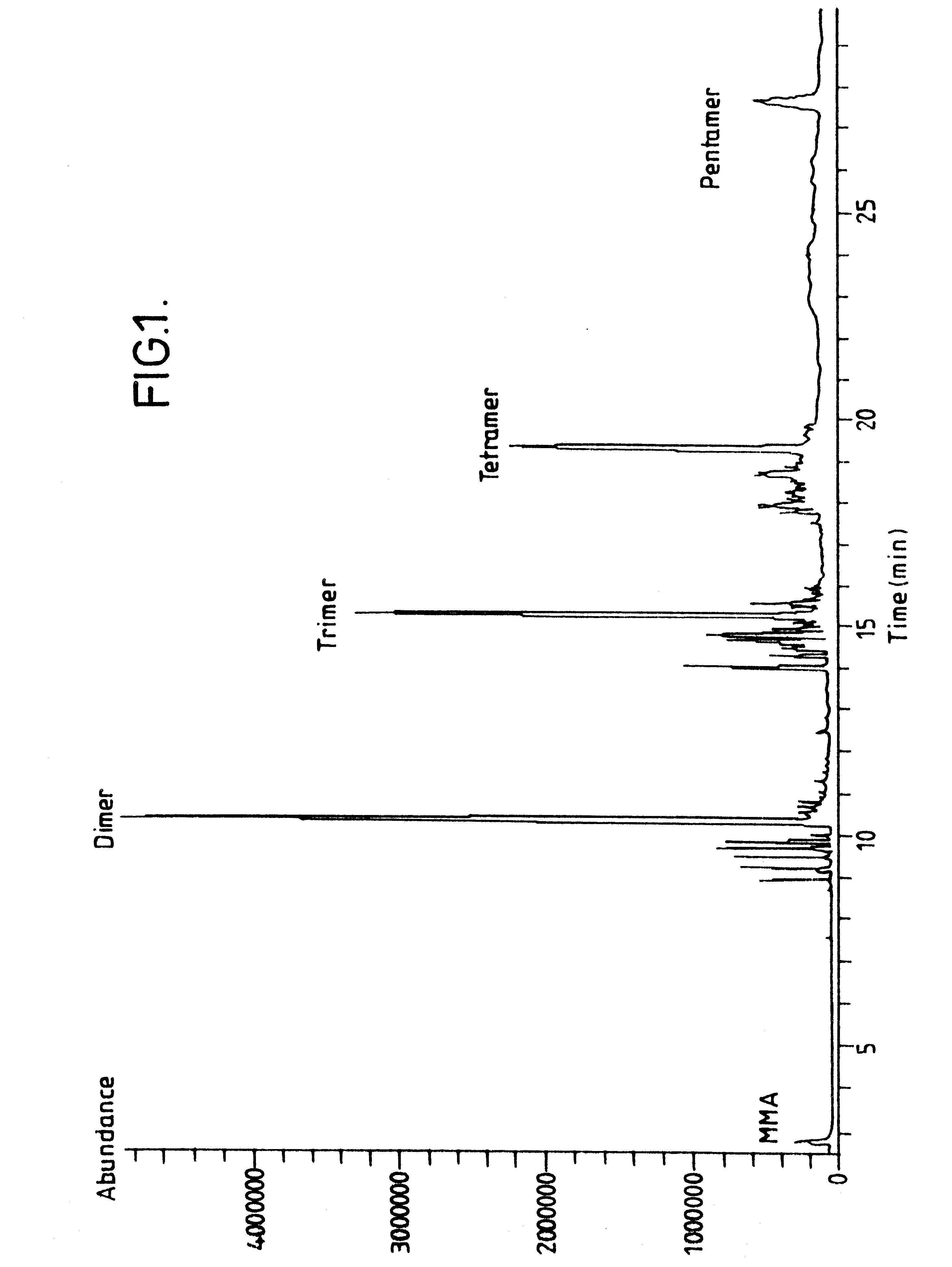Electrolyte cosolvents including acrylate and methacrylate oligomers
a technology of acrylate and methacrylate, which is applied in the direction of secondary cell servicing/maintenance, electrochemical generators, non-aqueous electrolyte cells, etc., can solve the problems of high flammability, high methyl acetate and methyl formate, and low molecular weight ethers are relatively flammable, so as to improve the efficiency of operation and safety, remove any heat of reaction, and improve efficiency
- Summary
- Abstract
- Description
- Claims
- Application Information
AI Technical Summary
Benefits of technology
Problems solved by technology
Method used
Image
Examples
example 1
A saturated oligomer of methyl methacrylate ("MMA") was synthesized according to the general CFSTR process described above. In this example, the reaction mixture was prepared with 1500 grams MMA having less than 2 ppm MEHQ and 75 grams 2,3-dimethyl-2,3-diphenylbutane hydrocarbon initiator (Perkadox-30, Akzo). Reactor temperature was 300.degree. C., reactor pressure was 830 psi, flow rate was 5.2-5.6 grams / minute. The reaction products prepared during the first hour were discarded while the reactor achieved a steady state. Over the next three hours, approximately 600 ml of a very yellowish reactor effluent (reaction product and unreacted monomer) was collected. Rotary evaporation at room temp at 200 microns pressure removed approximately 34% volatiles, resulting in 66% unsaturated MMA oligomer. The volatile-free oligomer was hydrogenated according to the general procedure described above and subsequently dried over molecular sieves to remove water.
example 2
A saturated oligomer of MMA was synthesized according to the procedure described in Example 1 except that no initiator was used in the reaction mixture. The reaction products prepared during the first 1.75 hours were discarded while the reactor achieved a steady state. Over the next 5.5 hours, approximately 1800 ml of a slightly yellowish reactor effluent (reaction product and unreacted monomer) was collected. GC-MS analysis of the reactor effluent showed the presence of MMA, as well as the unsaturated dimers, trimers, tetramers and pentamers of MMA. Volatiles were removed from the reactor effluent using rotary evaporation described above. Unsaturated dimer of MMA was fractionally distilled from the remaining unsaturated effluent using the wiped film evaporator as described above, and subsequently hydrogenated according to the general procedure described above. Saturated dimer of MMA was further dried over molecular sieves.
example 3
A saturated oligomer containing dimers, trimers, tetramers, and pentamers of MMA was synthesized according to the procedure described in Example 2. The reaction products prepared during the first 1.25 hours were discarded while the reactor achieved a steady state. Over the next 6.3 hours, approximately 2000 ml of a slightly yellowish reactor effluent (reaction product and unreacted monomer) was collected. Volatiles were removed from the reactor effluent using rotary evaporation as described above to yield about 43% nonvolatile unsaturated oligomer. Analysis of the GC-MS results of the unsaturated oligomer indicates the molecular weight distribution contains dimers, trimers, tetramers, and pentamers of MMA (see FIG. 1). The unsaturated oligomer was subsequently saturated according to the general hydrogenation procedure described above. The saturated dimer was subsequently fractionally distilled from the saturated oligomer using the procedure generally described above.
PUM
| Property | Measurement | Unit |
|---|---|---|
| temperature | aaaaa | aaaaa |
| boiling point temperatures | aaaaa | aaaaa |
| boiling point temperatures | aaaaa | aaaaa |
Abstract
Description
Claims
Application Information
 Login to View More
Login to View More - R&D
- Intellectual Property
- Life Sciences
- Materials
- Tech Scout
- Unparalleled Data Quality
- Higher Quality Content
- 60% Fewer Hallucinations
Browse by: Latest US Patents, China's latest patents, Technical Efficacy Thesaurus, Application Domain, Technology Topic, Popular Technical Reports.
© 2025 PatSnap. All rights reserved.Legal|Privacy policy|Modern Slavery Act Transparency Statement|Sitemap|About US| Contact US: help@patsnap.com



